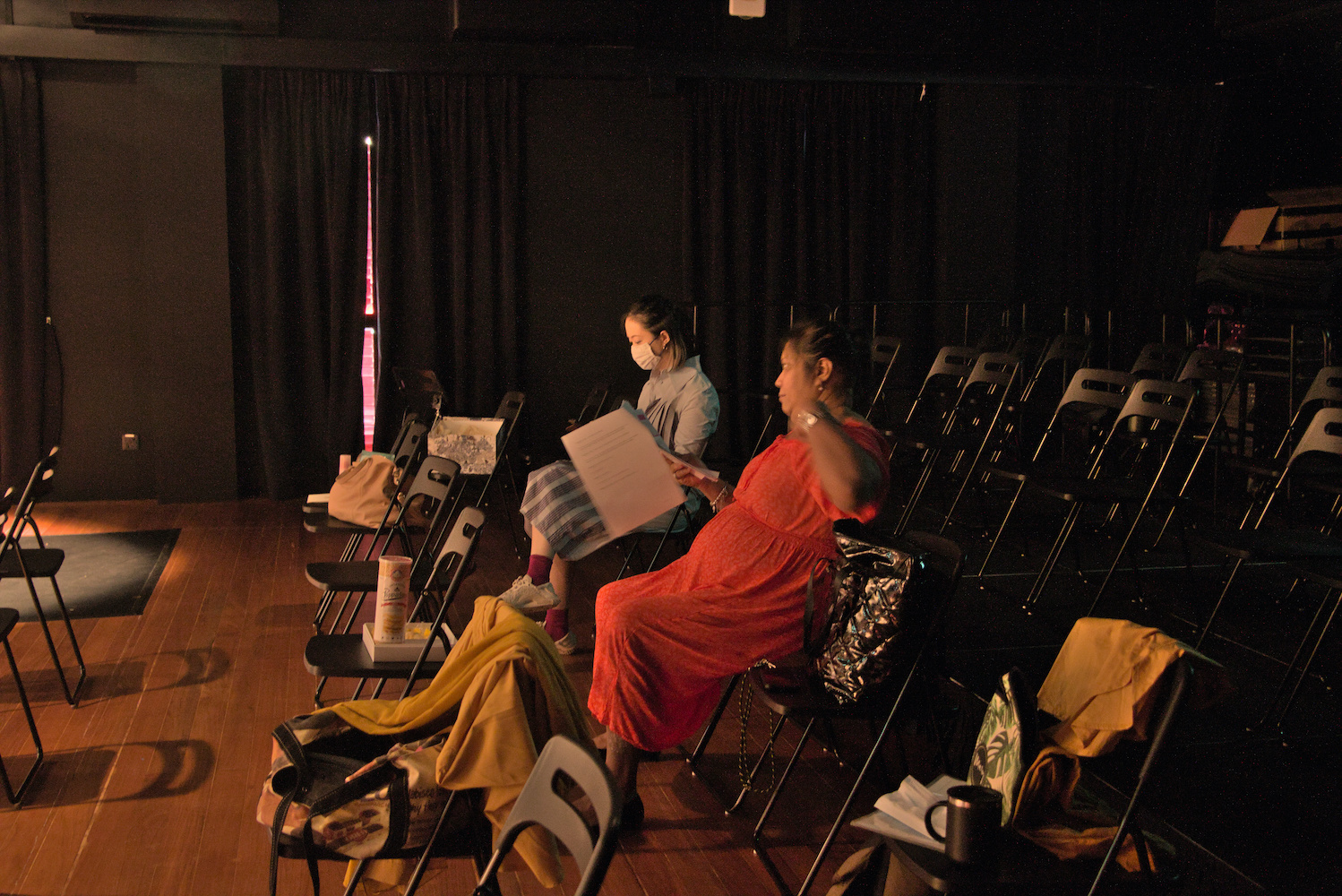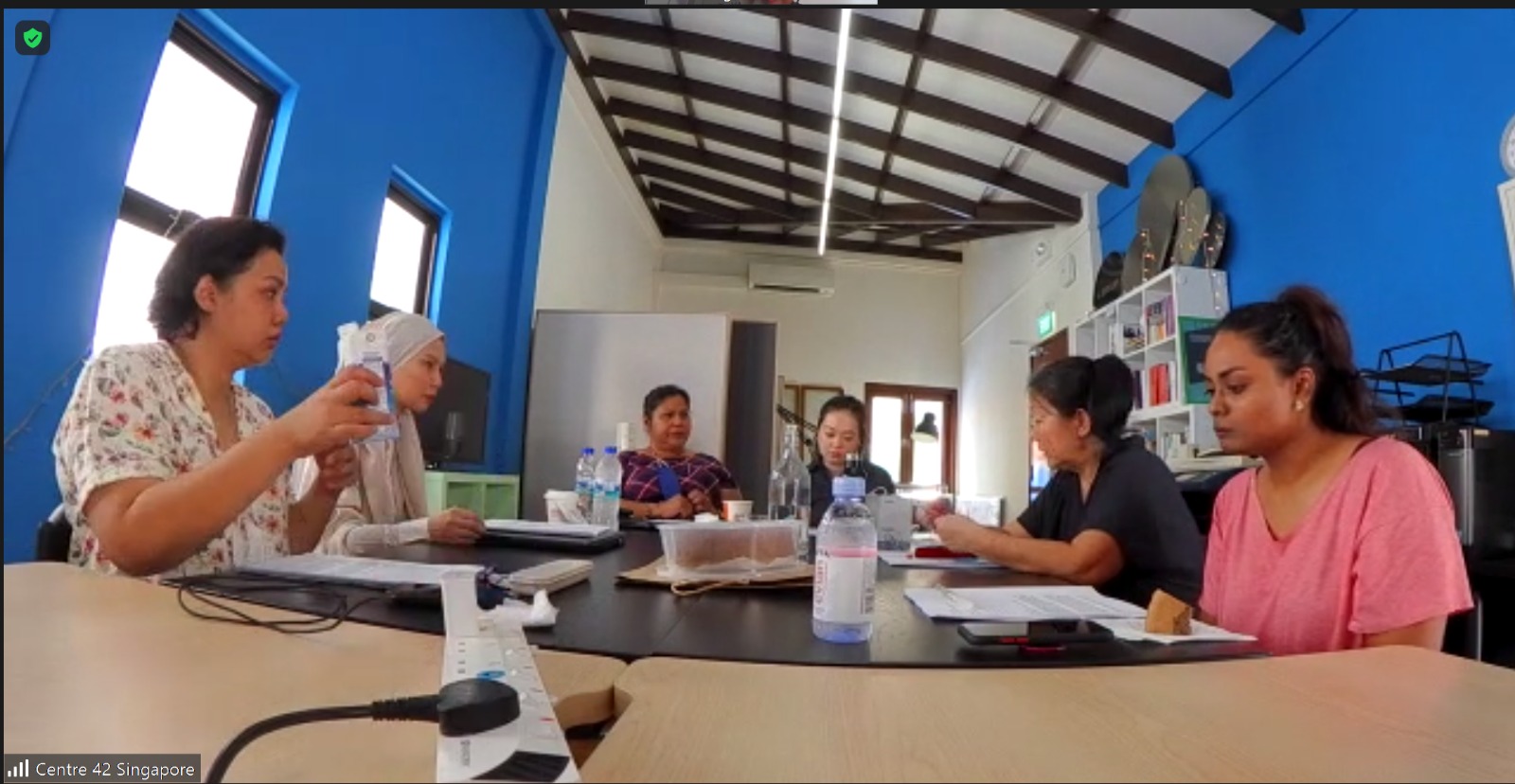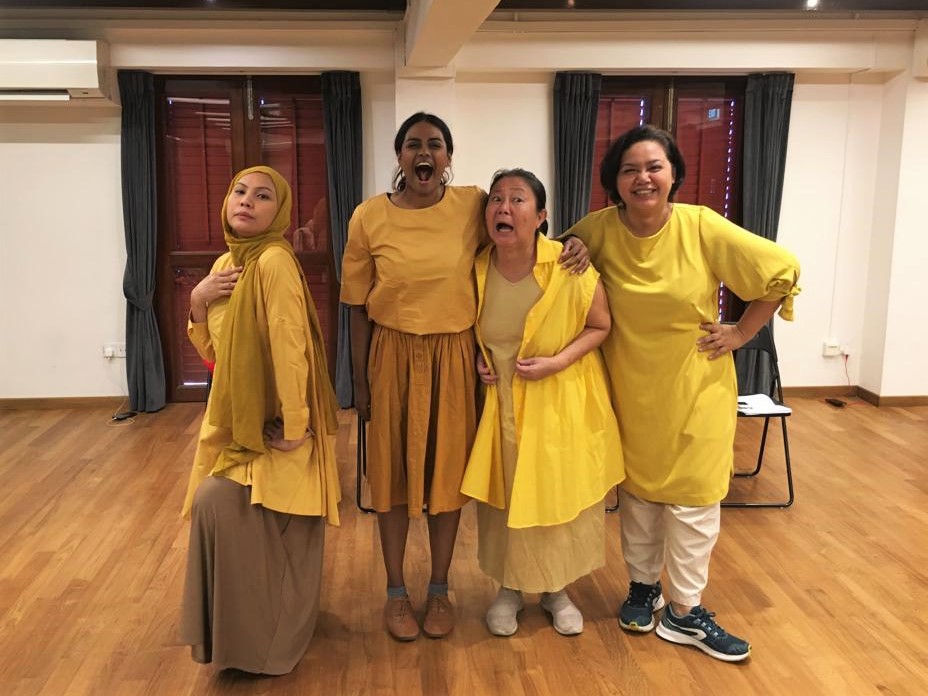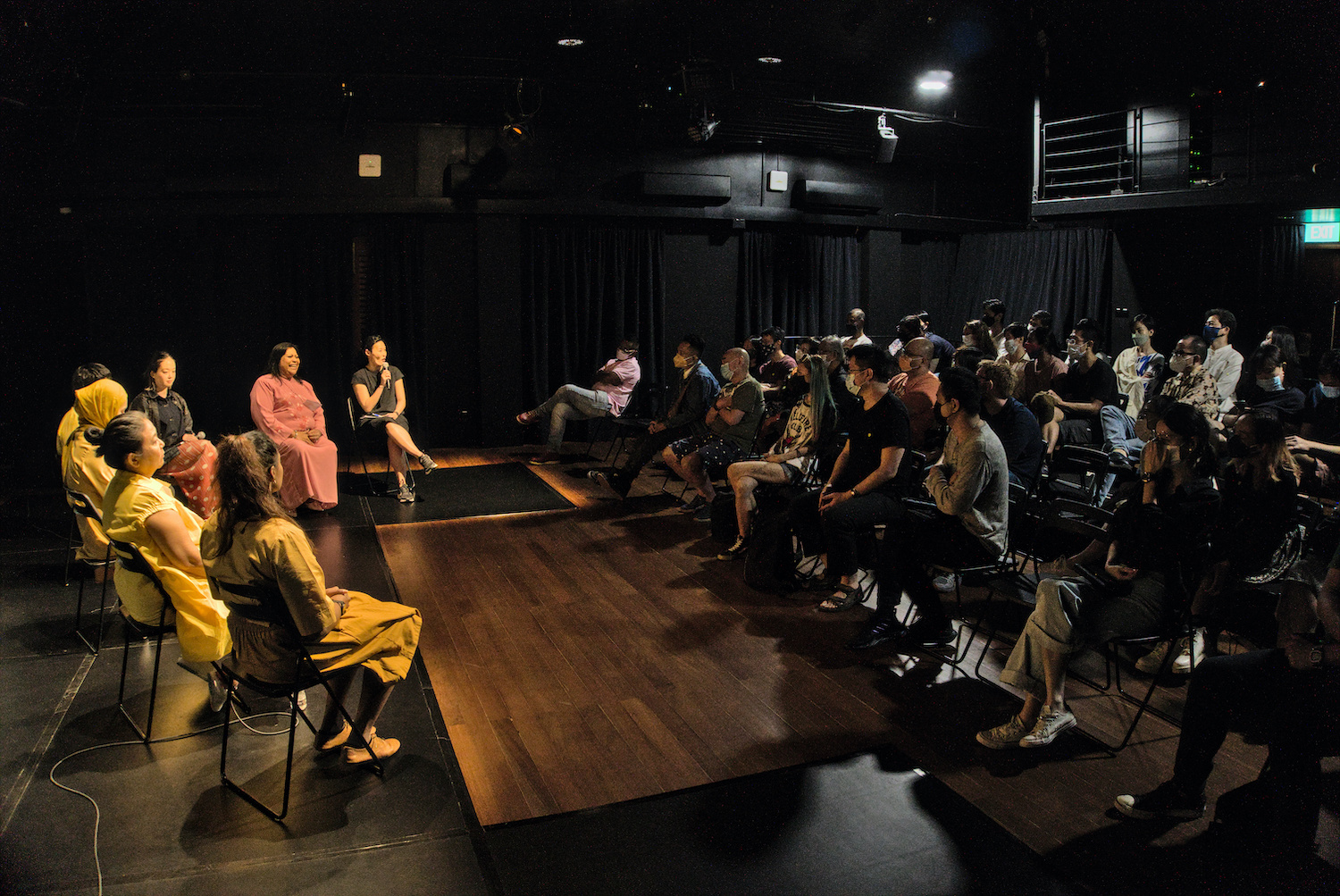Euginia Tan with Aidli ‘Alin’ Mosbit at the dress rehearsal for The Vault: Yeast

“Honestly speaking, I feel like I am the last person I thought would adapt an Elangovan play.”
Euginia Tan, the playwright of Yeast, muses as she considers if she had any hesitations on embarking on The Vault: Yeast, her adaptation of the 2006 play Smegma into an all female cast. Through the process of rehearsing for the dramatised reading up to the presentation, we checked in with Euginia to learn more about her thoughts on working with the original text of Smegma to develop this response.

Table read and discussion for Yeast on 9 May 2022.
The first chat we had with Euginia was on 23 June, at the time when rehearsals for the dramatised reading of Yeast were already underway.
What was your starting point in conceptualising Yeast?
When Centre 42 had an open call for The Vault: Lite in 2020, I was doing research to find something to submit. I decided to propose an idea to adapt Elangovan’s Smegma for the The Vault: Lite after reading The Good, The Bad and The Ugly: Three Banned Plays a few years back. I had always wanted to respond to the text ever since.
Later on a few months later, there was an open call for New Scripts Residency. So I sent in the idea again, and Shu Yu, the Programmes Executive of C42 then, very kindly said maybe this doesn't work for New Scripts Residency, but let's take it to The Vault instead. This culminated in The Vault: Yeast. I was so thankful for the opportunity!
What was your first reaction to reading Elangovan’s Smegma?
I felt quite affronted the first time I read the play; there were so many thoughts in my mind, like “how can anyone write this”, “this seems so wrong”, or “this is so mindless”! This strong reaction I felt about the text really intrigued me. So I did the ‘sensible’ thing: which was to read it immediately a second time, just to provoke myself.
Reading it for a second time, I came around to thinking that, hey, he might actually know what he's talking about. If I were to look at the entire play as a chess game, it felt like he knows what moves have to be made to reach a certain check in the whole game. I even started to feel quite sentimental towards the characters. Most people might find it quite hard to feel sympathetic or even empathetic towards Elangovan’s character. Sometimes the situations he puts people in feel far-fetched, but the more I look at the play, the more I believe that those situations do happen and can happen. It actually made me want to break out and look beyond whatever shelter I was in. That was the beauty of this piece of writing for me.
Smegma was the first play that I found poetic, in terms of how graphic and violent it was, despite the chaos and the turbulence around it. A lot of other plays that I had read or experienced up until that point were either quite naturalistic or steeped in history. Elangovan wrote in a very different trajectory from those plays, and I think many people experience that from his works. Those who read it tend to yield to his writing, you know.
I feel I'm still very new to theatre, and so that sort of writing for theatre is very important to me. At the same time I was also thinking about how there were a lot of shows I have watched that did gender reversals from female to male roles. I've seen a lot of all-male ensembles or male adaptations, such as Wild Rice’s The Importance of Being Earnest or Best Of (His Story). That perspective was very different from how I imagined adapting Smegma.
Why did you name this adaptation “Yeast”?
We originally wanted to just keep it to Smegma. Initially when I approached Aswani Aswath with the intention of having her to direct it, she asked for the title of the response to be “something safe”. When I thought of “Yeast” as the title, we felt like that could be a little too explicit in how it refers to a yeast infection. To her credit, she ultimately suggested we shouldn’t turn the idea down, since it is in line with the theme and the feel of the original play, and we should go ahead with it. I also feel like “Yeast” is quite suggestive. It doesn't merely suggest an infection, it is also an ingredient in baking, or brewing, which is something generative rather than destructive. Ultimately, Aswani did not join this project as the director, but her suggestion stuck.
What kind of changes did you have to make to the dialogue in adapting from male characters to female characters?
Something I had to do was to code-switch between the characters. It’s like how males talk to each other, especially in an aggressive way, the same would apply for females who are being aggressive, either to someone else or to each other. An example of this would be the scene “Holy Smoke”, which in Smegma was an exchange between two men and one woman, where a Chinese couple were complaining about a Malay man who was smoking. In the original text, there was actually a lot more bravado. When I adapted the scene for three women to perform, a code-switch happened where in place of the bravado, the tone became more like finger pointing and a little bit more petty, even though it was the same grievance. In the process, the weight or the scale of this conflict somehow became different by quite a bit.
I have to credit Alin's direction for a lot of the code-switching that was made in adapting male to female characters. She brought about a lot of nuances that the lines held. In addition, the energy that the cast bounced off on each other contributed to the weight of the lines. It made me reconsider how to make these lines malleable enough for the cast to play with. I read the play over and over and over again, seeing which parts could be taken out and which parts could be re-inserted.

From Left to Right: Nessa Anwar, Rebekah Sangeetha Dorai, Neo Swee Lin, Joanne Ng during rehearsals for Yeast.
On the day before the presentation of The Vault: Yeast, the Arts Entertainment Licence was granted after some edits were made to the play. On 30 June, we chatted with Euginia to hear her thoughts on having her adaptation ready for the dramatised reading.
Congratulations on having the licence for the dramatised reading of Yeast approved! How was it like negotiating for the approval of the licence?
Before we got the performing licence, we were advised to edit the vignette “Shahid Game” as there were concerns about portraying the deaths of children and that 'Shahid' was described as a 'game'. In the first draft of that edit, I changed it such that the female terrorist, played by Nessa, ends up giving birth on stage.
While I thought it could be an interesting angle to explore, I realised I probably should not do this because Nessa really is pregnant. I called her to ask if she would be okay with this edit and she refused straightaway. By now she’s seven months pregnant and is starting to feel a lot of emotions. So I went back to the drawing board and created a more ambiguous ending for the vignette. So yes, there is an alternate ending for this play
Looking back, now that we’re at the dramatised reading, how was the rehearsal process like leading up to this?
It's been very smooth. Throughout this whole process, I was curious as to how Elangovan would feel. Naturally, now that the dramatised reading is approved for reading, I kept thinking about what his opinion on this would be. However, it's quite hard to get an emotional response other than anger out of him. We only had two email exchanges because of his work schedules, and I respect that he wants to maintain a certain sense of privacy. But I’m glad he gave his approval for the play to be re-adapted and for being willing to see this revision with reversal of the characters’ genders.
The cast have good synergy, even though it's the first time that most of them are working together. Alin knows most of them already. I love them, they all have different capacities of writing, directing, stage managing and design. So between them they share a lot of stage experience to a point where they feel familiar and comfortable with each other. I think that gave them a lot of room to play and explore. Because what Alin wants is for them to also be very playful during the process.
The team also gave me a lot of pointers and inspiration for further development of this work. I'm very lucky to have them; it has become hard for me to imagine Yeast with a different set of actors now.
What are you expecting the audience's reaction to Yeast be?
The interesting thing about Smegma is that when it comes to reactions to the work, I either get a horrified response of: “Why would anyone write a play called Smegma?”, or a completely different response, which is “Huh? What does ‘smegma’ mean?” There has never been a response that falls in between these two.
I thought that maybe this parallels the hidden violence that we face. When you think about violence, people who really know and experience it have an immediate reaction towards violence, while those who may not have had a lot of contact with anything like that with it just remain ignorant of what is happening. Smegma is a good representation of that situation. I hope that Yeast honors that effect Smegma has had on audiences

Post-show dialogue after the dramatised reading of Yeast.
A few weeks after the presentation had concluded on 26 July, we chatted with Euginia once again to find out more about her thoughts from the dramatised reading of the play, and whether there are any further explorations she would like to do with Yeast.
Now that the dramatised reading is done, what are your thoughts on the audience’s reactions?
Alfian Sa’at gave two points about the censorship of Smegma during the post-show discussion that made me think a little bit. So the first point he raised was that the original reason why Smegma was banned was that they would be offensive to Muslims in Singapore. He felt that, you know, that was seeing the Muslim community in a certain vein, which was unfair to assume that Muslims can only accept a certain kind of content. It seems to be a larger systemic issue, one which we cannot place the blame solely on iMDA.
The second thing that Alfian pointed out was his reaction to my comments that I actually felt like the censoring gave me some leeway to exercise my creativity because I had to change the ending of the dramatised reading. He said that he used to feel like that when he was writing in his younger days. Later on he wondered if it was a kind of learned helplessness to claim that I'm going with this narrative of the writer who has to adapt quickly.
One part of me was a little bit indignant at the suggestion. The other part of me embraced the suggestion and I was thinking that I have to be open to the fact that I am a product of the system and I probably don't really have as much creative autonomy as I think I do.
Are there any possibilities for a further expansion of themes explored in Yeast?
We had a conversation separately on how perceptions of male-on-female violence differed significantly from female-on-male violence. That conversation got me thinking what the threshold of violence is for men versus women? And how that violence occurs within family units as well. That would be a starting point for a possible future project.
To add to that, I do hope that more of Elangovan’s works can be published and staged for the public, and not just an audience well-versed with theatre history.
Published: 15 August 2022